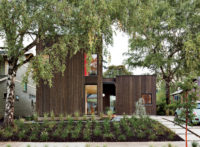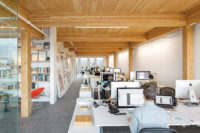Continuing Education: Relocating Buildings
Moving Masterworks: Three important buildings with new sites demonstrate the challenges and opportunities of relocation.

Photography courtesy Crystal Bridges Museum of American Art, Nancy Nolan

The original entry sequence was recreated on the grounds of the museum.
Photography courtesy Crystal Bridges Museum of American Art, Nancy Nolan

To prepare the house for its move, the project team deconstructed all wood surfaces, built-ins, and windows and installed them on a new masonry and wood structure.
Photography © Tarantino Studio

The Bachman Wilson House’s disassembled elements were carefully catalogued before being shipped to Arkansas.
Photography © Tarantino Studio

In its new location, as with its first site (shown), the living area looks out onto an outdoor room defined by deciduous trees.
Photography © Tarantino Studio

In its new location (shown), as with its first site, the living area looks out onto an outdoor room defined by deciduous trees.
Photography courtesy Crystal Bridges Museum of American Art, Nancy Nolan

Frank Gehry’s 1987 Winton Guesthouse made its first move starting in 2009, from Wayzata, Minnesota, to a conference center site about 110 miles away (shown).
Photography © Mike Ekern/University of St. Thomas

The two-year relocation process for the guesthouse entailed separating its elements and moving each on flatbed trucks. The house will soon be relocated again, this time to Upstate New York.
Photography © Mike Ekern/University of St. Thomas

In order to include an 1845 church in Cambridge, Massachusetts, in an arts complex it was designing for Lesley University, Bruner/Cott moved the structure about 80 feet to the south.
Photography © Robert Benson

The church’s former location on a corner did not work well with the siting for the new building.
Photography courtesy Bruner/Cott

Preparations for the move included removing the steeple and cutting slots in the lower portion of the exterior walls so that steel beams could be slid under the floor structure.
Photography courtesy Bruner/Cott

A skylit atrium connects the old and new structures.
Photography © Robert Benson












Architects spend a great deal of time making sure their buildings stay put. But the whims of nature and real-estate development can uproot the best of plans and make relocating an important structure the only way to save it. Most historic-preservation professionals are loath to sanction the relocation of a significant building except under the most extreme circumstances. “It has to be the last resort,” says Xana Peltola, Heritage Preservation Specialist for the state of Minnesota and author of the 2007 study Moving Historic Buildings. What follows are three case studies of structures without other viable options.
PIECE BY PIECE
Architects Lawrence and Sharon Tarantino, of Tarantino Studio, served as consultants on the recent relocation of their own Frank Lloyd Wright–designed house from its original site in Millstone, New Jersey, to Crystal Bridges, the American art museum created by Walmart heiress Alice Walton in Bentonville, Arkansas. The Tarantinos bought the 1954 Usonian house in 1988, originally built for Gloria Bachman and Abraham Wilson, after it had suffered from decades of neglect and aesthetically obtrusive changes. They then spent the next 10 years restoring the concrete-block and woodframe structure and its classic Usonian
features such as exterior and interior horizontal board and battens, radiant-heated, colored concrete floors, and a generous, light-filled living area.
What the Tarantinos hadn’t anticipated were the damaging floods caused by hurricanes Hugo, Floyd, Irene, and a string of lesser storms. By the time superstorm Sandy came roaring up the eastern seaboard in late 2012, the couple had devised an exhausting regimen that entailed removing cabinets, appliances, and furniture and storing them on higher ground before the storm made landfall, though, fortunately, the area missed the brunt of Sandy’s wrath.
Before that storm, the couple had begun considering relocating the house. “Around the time Floyd hit in 1999, we started looking at options to move it,” Lawrence Tarantino says, pointing to climate change and regional development as causes of the increase in flooding.
After their prolonged search for a buyer, Walton agreed in 2014 to purchase the house (the price has not been disclosed) and move it to the grounds of the Moshe Safdie-designed museum in Arkansas. The house opened to the public on its new site in November 2015.
According to Peltola’s study, the preferred relocation method is to move a building in one intact piece, since this approach has the least impact on the historic fabric of the structure. Other methods include partial disassembly, and total deconstruction. Building size, construction type, and the logistics of transportation are among the factors that determine the best approach to relocation.
Distance is often the prime consideration. The Gordon House, another two-story Usonian that was completed in 1964 (after Wright’s death) in Wilsonville, Oregon, was moved about 20 miles to the Oregon Gardens in 2001. As with the Tarantinos’ house, the first level was primarily concrete-block construction, so the upper, wood-frame level was sawed off its base, loaded onto a flatbed truck, and moved in one piece. But given that the Tarantinos’ house was to travel much farther—almost 1,300 miles— the project team decided to remove the wood surfaces, built-ins, windows, and doors and reinstall them on a new masonry and wood structure at the Arkansas site.
The Tarantinos were in charge of the deconstruction process and served as advisors for the relocation and reassembly. They produced three sets of documents for the project: as built drawings, deconstruction drawings, and reconstruction drawings.
Starting with interior elements in February 2014, disassembly of the house took about four months. Every element, from the Philippine mahogany board and battens to cabinets and furniture, was cataloged, stored, and finally shipped by truck to Bentonville. Upon arrival, the pieces were laid out on the floor of an aircraft hangar according to their position in the house. The construction team made repairs and mocked up elements like pieces in a jigsaw puzzle, before the materials were delivered to the site.
In her study, Peltola emphasizes the concept of replicating the “aesthetic tone” of the original context. The site on the Crystal Bridges campus was modified to simulate the original conditions as closely as possible. But while the New Jersey lot was relatively flat, the Arkansas site is on a hillside behind the museum, so a stone retaining wall was built to create a level area. Wright had intended the living area to focus on nature, so, in its new location, as with its first one, the house has an outdoor room< defined by deciduous trees, with a stream in the distance. The building was laid out with the same orientation as the original, and the entry sequence was recreated as closely as possible.
Even though Wright’s Usonian houses were similar to each other, as Frank Lloyd Wright Conservancy preservation architect John Thorpe points out, “They were designed by Wright specifically for their sites.” The Conservancy, an organization dedicated to preserving Wright’s work, typically sanctions the relocation of a project only when it saves it from demolition. But Thorpe was convinced that there was no other option for the Tarantinos’ house. At his urging, the organization endorsed the move.
Although the original structure was thoroughly documented, inconsistencies were bound to crop up during reconstruction—especially since the original elements were integrated with all new concrete flooring, block walls, and wood framing. For example, the house was built on a four-foot grid that was incised into the concrete floor. But several of the grids were slightly off in the original house, while the new structure was built precisely on Wright’s grid. The irregularities were compensated for in areas such as closets as much as possible, according to Scott Eccleston, director of operations for Crystal Bridges.
The reconstruction process also presented opportunities, such as insulating the roof and installing a state-of-the-art HVAC system. “We drew the line at anything that could be seen– even if there was an opportunity to improve the function,” says Eccleston. “We wanted to be true to Wright’s design.”
HOUSE ON THE RUN
Since Frank Gehry’s 1987 Winton Guest House was designed as a collection of six distinct, though connected, forms, transporting each volume separately worked well for its first relocation in 2011. The clients had requested that the guesthouse—originally sited adjacent to Mike and Penny Winton’s midcentury Philip Johnson house in Wayzata, Minnesota—not compete with Johnson’s rigidly rectilinear structure. Gehry’s response was to treat the guesthouse as a sculptural object in the landscape based on a three-dimensional interpretation of the still life paintings of Giorgio Morandi. Victoria Young, architectural-history professor at the University of St. Thomas, in Owatonna, Minnesota, considers the design— a montage of diverse volumes clustered around a tall pyramidal living space– to be a seminal work in Gehry’s evolution toward exuberant sculptural forms. Each element in the 2,300-square-foot composition is one room with its own shape, material, and function, including the living room, sheathed in sheet metal, and a limestone-clad curvilinear bedroom piece.
When a developer bought the Wintons’ property, he donated the guesthouse to the university, some 110 miles away. In 2009, movers began a two-year process of separating the elements of the house, transporting each on trucks, and then reassembling and restoring the house at the university’s Gainey Conference Center site. The 60-ton bedroom module presented a particular challenge: once slid on beams to a flatbed truck, it was moved at about walking pace for the entire journey to prevent damage.
The house barely had time to settle into its new site when, last year, the conference center was sold and the school was given until August 2016 to remove the house from the property. Placed on the auction block in May 2015, the house sold for $750,000 (shipping not included) to an anonymous buyer in New York’s Hudson River Valley. Harrison Design is coordinating the move and working directly with Gehry Partners on the restoration work to ensure that the detailing is consistent with the original.
The second relocation presents opportunities to restore the relationship between the house and its site, according to Greg Palmer, a Harrison Design principal. “At the Owatonna site, it was difficult to see the building the way it was intended to be viewed,” he says. The house had been rotated 180 degrees from its original orientation, which made the experience of the approach different from what was intended. Gehry designed the house so that facades facing the Wintons’ home were without windows, which emphasized the sculptural quality of the work. On the Hudson Valley site, the new owners also plan to position the house so it has a similar relationship to their primary residence, as it did with the Johnson structure.
The design team considered moving the separate rooms of the house on barges through the Great Lakes, then down the Erie Canal to the Hudson River, but the logistics proved too daunting. With Gehry’s approval, they opted to disassemble the more cumbersome elements, such as the limestone-clad bedroom module, and transport the structure overland.
As with the first relocation, smaller rooms such as the brick fireplace alcove will be moved on flatbed trucks once the masonry chimney is removed. Other elements, such as the wood-framed living room walls, are being separated into wall or ceiling panels. The current relocation will also allow the project team to improve flashing details and to restore the connections between the elements, according to Palmer. (The deconstruction process has begun, but no date has been set for completion.)
ON THE SKIDS
As with the Winton guesthouse, the North Prospect Church in Cambridge, Massachusetts, was destined for multiple moves. The Greek Revival–style wood-framed structure, built in 1845, was moved a mile down Massachusetts Avenue in 1867 by a team of horses. And, just two years ago, the church was moved about 80 feet to the south in order to include it in Lesley University’s new Lunder Arts Center, completed in 2015.
The church’s corner location didn’t work well with the siting for the new building, says Simeon Bruner, a principal at Bruner/Cott Architects, the arts center’s designer. The firm decided to slide the church toward the center of the block and couple it with the new building, connecting the two with a glazed atrium.
To prepare the historic building for relocation, the steeple was removed, interior finishes were taken out, and a series of cable X braces were rigged across the interior for lateral stability. Carpenters cut slots in the siding of the lower walls so that steel beams could be< installed under the floor structure. Hydraulic jacks capable of a three-foot “throw” then pushed the structure along the beams in 36- inch increments. The structure was in place over a new foundation in less than a day.
In the process of the second move, the building was lowered to its original elevation above grade, restoring its intended proportions. Bruner/Cott preserved the church’s exterior, restoring the striking stained glass windows and carefully detailing the glass walls and roof of the atrium so that they quietly meet the historic facade. The church had three different steeples over its lifespan, two of which were destroyed in storms. Curiously, the architects chose to replicate the second, 1906 version rather than the original. According to Bruner, it has a more secular character that fits the building’s new academic use. The interiors, meanwhile, were changed radically, with an upper floor added above window height to house studios and a library over the nave.
Despite all the modifications, the building, which was listed on the National Registry of Historic Places in 1983 and earned local landmark status in 2009, retained its designations. The interior was not landmarked. “We worked very carefully with the Cambridge Historical Commission to remove elements that were historically inappropriate and replace original materials that had been removed,” Bruner says.
MOVING INTO THE FUTURE
It’s likely that relocating important buildings will become even more frequent. Post-Katrina New Orleans has seen a boom in the business of moving houses out of harm’s way. In 2015, the entire town of Kiruna, Sweden, began migrating to a nearby site because of subsidence from Europe’s largest iron ore mine. Most of the town will be rebuilt, but historic buildings will be moved to the new location. With the world getting more crowded, and with rising sea levels and expanding flood plains, there is no doubt we’ll see more historic structures on the move.
|
Continuing Education

To earn one AIA learning unit (LU), including one hour of health, safety, and welfare (HSW) credit, read “Moving Masterworks,” review the supplemental material listed below, and complete the online test. Upon passing the test, you will receive a certificate of completion, and your credit will be automatically reported to the AIA. Additional information regarding credit-reporting and continuing-education requirements can be found online at continuingeducation.bnpmedia.com.
Supplemental Material
Moving Historic Buildings: A Study of What Makes Good Preservation Practices When Dealing with Historically Significant Buildings and Structures (Chapters I and II)
Xana Peltola
Learning Objectives 1 Debate the ethical issues involved in moving significant buildings. 2 Describe different methods for relocating buildings. 3 Describe methods for preventing damage to structure, finishes, and other original fabric when a building is moved. 4 Discuss the challenges presented by moving the Bachman Wilson House, the Winton Guest House and the North Prospect Church. AIA/CES Course #K1602A
For CEU credit, read "Moving Masterworks" and take the quiz at continuingeducation.bnpmedia.com, or use our architectural record continuing-education app, available in the itunes store.
structure, finishes, and other original fabric when
a building is moved.
significant buildings.
|


















